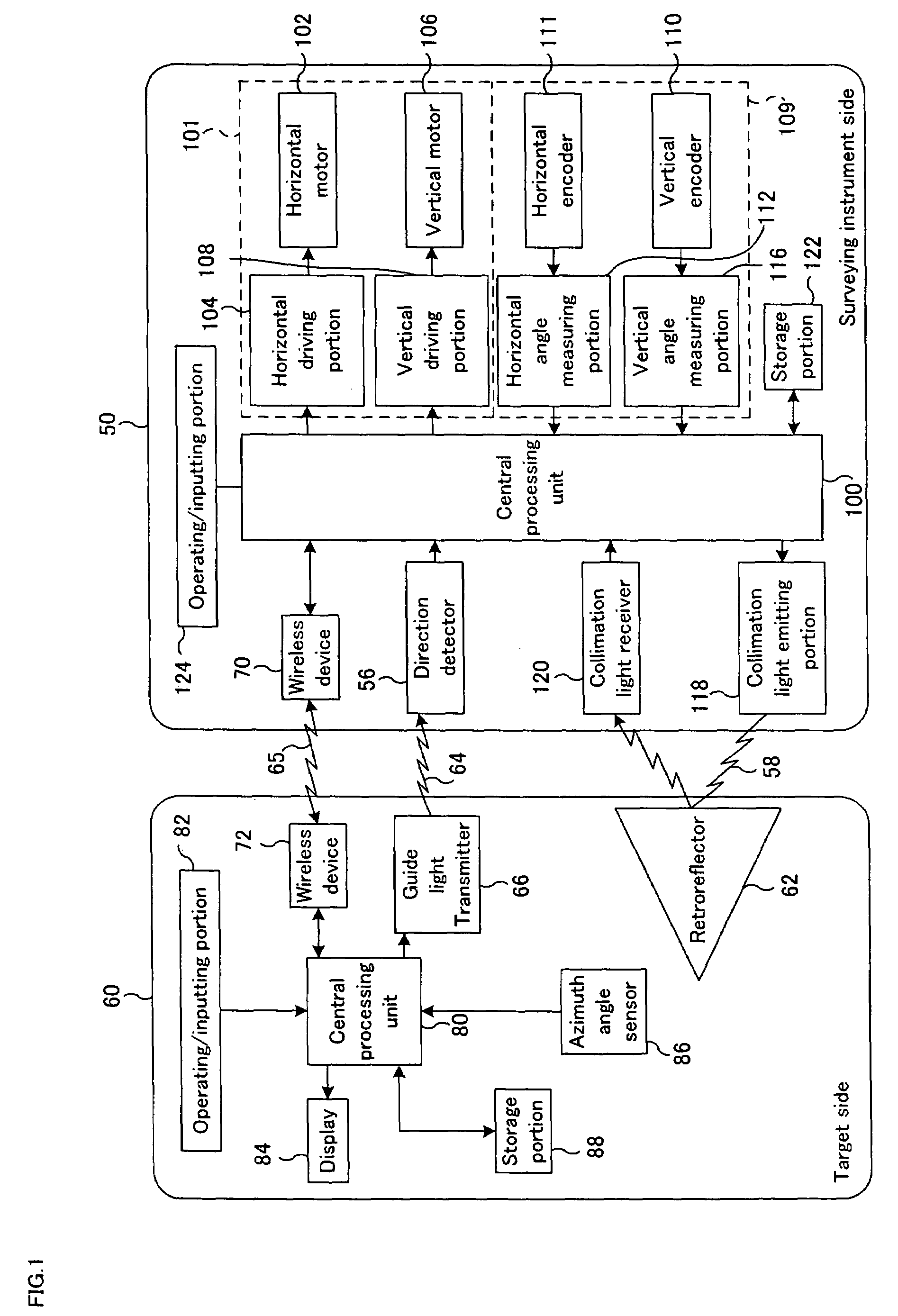Survey system
a technology of survey system and automatic collimation, applied in the field of survey system, can solve the problems of inability to smoothly perform survey and consume a lot of time for automatic collimation, and achieve the effect of reducing the time required for automatic collimation, and reducing the burden on the operator
- Summary
- Abstract
- Description
- Claims
- Application Information
AI Technical Summary
Benefits of technology
Problems solved by technology
Method used
Image
Examples
first embodiment
[0040]First, the present invention will be described with reference to FIG. 1 to FIG. 3. FIG. 1 is a block diagram of the whole of a survey system according to this embodiment. FIG. 2 is a view for explaining the principle of the present invention. FIG. 3 is a flowchart explaining a process for adjusting the body of a surveying instrument approximately toward a target in this survey system.
[0041]As shown in FIG. 1, the survey system has a target 60 including a guide light transmitter 66, an azimuth angle sensor 86 that measures the direction of the target 60, and a storage portion 88 that stores a direction angle (azimuth angle) measured by the azimuth angle sensor 86. A central processing unit (CPU) 80 is connected to the azimuth angle sensor 86 and the storage portion 88. The central processing unit (CPU) 80 causes the azimuth angle sensor 86 to measure a direction angle and causes the storage portion 88 to store this direction angle every time the distance and angle are measured ...
second embodiment
[0059]In the flowchart of FIG. 7, an angular difference Δθ between the direction angle θB obtained at the present time and the direction angle θA obtained at the last time is calculated at step S25 in the same way as in the second embodiment shown in FIG. 4. However, in this embodiment, the process then proceeds to step S40, at which a comparison is made among the angular difference Δθ, the maximum estimated error angle E and the safe error angle E′.
[0060]If E+E′41, at which the rotational direction of the instrument body 52 is determined in the same way as in the first embodiment, and a rotation command of a rotational pattern P1 by which the instrument body 52 is simply rotated in an indicated rotational direction is formed (see FIG. 6(A)).
[0061]If E42, at which the excessive angle θ1 is determined as θ1=Δθ+E+E′, and a rotation command of a return-type rotational pattern P2, by which the instrument body 52 is rotated by the excessive angle θ1, and continues to be reversed (see FIG...
third embodiment
[0076]FIG. 6 View for explaining a rotational pattern by which the instrument body is rotated in the survey system according to the present invention.
[0077]FIG. 7 Flowchart explaining a process for positionally adjusting the instrument body approximately toward the target in the survey system according to the third embodiment.
[0078]FIG. 8 View showing the outline of the conventional survey system.
[0079]FIG. 9 Block diagram of the whole of the conventional survey system.
[0080]FIG. 10 Flowchart explaining the measuring process of the conventional survey system.
PUM
 Login to View More
Login to View More Abstract
Description
Claims
Application Information
 Login to View More
Login to View More - R&D
- Intellectual Property
- Life Sciences
- Materials
- Tech Scout
- Unparalleled Data Quality
- Higher Quality Content
- 60% Fewer Hallucinations
Browse by: Latest US Patents, China's latest patents, Technical Efficacy Thesaurus, Application Domain, Technology Topic, Popular Technical Reports.
© 2025 PatSnap. All rights reserved.Legal|Privacy policy|Modern Slavery Act Transparency Statement|Sitemap|About US| Contact US: help@patsnap.com



